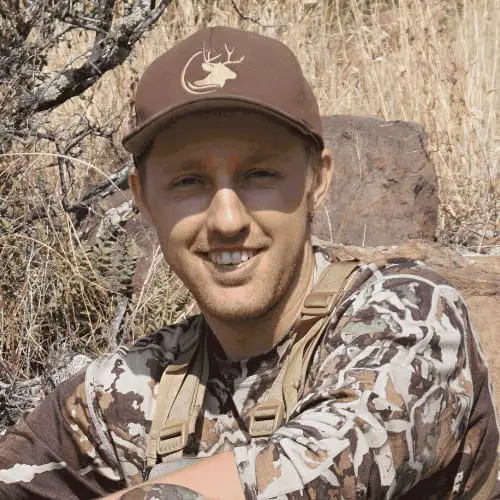Fact checked by Steven Lines, lifelong Hunter and Outdoorsman .
.
Elk live in a wide range of different terrains and habitats. From the top of giant mountain peaks down to the low rolling hills, elk are tough animals that can adapt to survive in just about any type of condition. But what about after a forest fire? Do elk like burned areas?
Elk love burned areas. While they will avoid areas with active fires, after the fire is gone, elk will move into the area to feed on the fresh grass shutes that sprout thanks to the burned vegetation.
Burned areas also provide more visibility and room to run for the elk herds, making them ideal areas to find, observe, or hunt elk. Continue reading to learn more about burned areas and how they can be some of the best elk habitats and places to find elk.

In this post, we'll cover:
Where Do Elk Prefer to Feed?
Although elk typically live in the forests of the western United States and Canada, they are browsers that graze on grass. During the day, elk will typically hide out in the thick forests where it is quiet and cool. At night, however, they will venture into open meadows and fields where they can graze on the grass.
Elk love these open areas to feed and socialize with other elk. They are very social animals, so it is not uncommon to see dozens or even hundreds of elk together in a single field. This is also a reason why elk love burned areas so much.
After a forest fire moves through an area, the thick vegetation and overgrowth are all gone. The new open spaces and ample sunlight are the perfect combinations with the fire leaving behind new nutrients in the soil. All of this creates plenty of new feed for local elk populations.
Once a fire is completely gone, elk will slowly move back into burned areas. This is especially true after a good rain in a burned area, as the new grass will start to grow rapidly. Burned areas are prime feeding grounds for elk in many locations.
Do Wildfires Affect Elk Hunting?
Active wildfires will move elk out of an area temporarily. Elk are smart animals and know to leave an area during an actively burning fire. Do not expect to find many elk if there is a nearby wildfire, especially if it is a large one.
Once a wildfire is out, elk will slowly return to the area. This process could take weeks or months, but eventually, elk will realize the fire is no longer burning and return due to the ample foraging opportunities and excellent habitat that a burned area will provide.
Does Campfire Smoke Scare Elk?
It is no secret that scent is one of the most important aspects of getting close to elk. Elk have excellent noses and can smell a person from over a mile away. This might be why so many hunters are under the false assumption that campfire smoke can cause you to smell and scare away any elk.
Elk, however, are used to the smell of smoke because of the burned areas they like to frequent. Some hunters purposely cover themselves in campfire smoke to mask their natural human scent. Regardless of whether this actually works or not, elk are not actually scared of campfire smoke.
Elk are much more afraid of loud, unnatural sounds or human scents. These will quickly scare away any nearby elk if you are not careful. If you can, stay downwind of elk to help avoid casting your scent towards them. By staying quiet and keeping your scent downwind, you stand a much better chance of closing the distance to any elk.
How to Find Elk in Burned Areas
Burned areas are excellent places to find elk. Not only are elk attracted to these areas because of the abundance of food, but they are easy to pick out due to the lack of leaves and branches on the burned trees. Because of this, elk are much easier to find in burned areas than they are elsewhere.
The best way to begin finding elk in burned areas is to locate one of the highest points in the burned area that you want to explore. Getting to the top of this point, take out your binoculars and slowly being looking through the surrounding areas to try and locate elk. This is much more productive than hiking and hoping to get lucky and bump into the elk.
This method of finding elk is called glassing, and it only works in open areas like burned locations. A burned area will have no leaves or branches blocking the forest floor, allowing you better pick out the elk in their natural habitat. Once you finally locate the elk, you can observe them and decide your next course of action to get closer to them.
Final Thoughts
Although it may not seem like it, burned areas are actually incredible habitats for animals like elk. After a forest fire, the ground is ready and primed to start sprouting new growth, providing excellent feed for the elk. The opened areas allow elk to see further and spot predators, and the wide open spaces allow them better escape paths.
If you are actively looking for elk and there is a burned area nearby, that would be a great place to start your search. Elk not only like burned areas, they love them!

Steven Lines is a hunter and outdoorsman from Safford, Arizona, USA. Since he was a child, he has been hunting and fishing and has over 20 years of outdoor experience. Steven works as a hunting guide in Arizona during his spare time and runs a Youtube channel dedicated to sharing his outdoor adventures with others.
dedicated to sharing his outdoor adventures with others.
Sources
- https://blog.eastmans.com/hunting-burns-the-good-the-bad-the-ugly/

- https://www.onxmaps.com/hunt/blog/scout-forest-fires-for-hunting-opportunities

- https://forums.bowsite.com/tf/bgforums/thread.cfm?threadid=354297&forum=5

